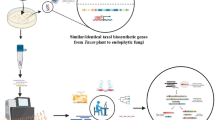Summary
Extramatrical mycelium and outer hyphae of the sheath ofEucalyptus pilularis-Pisolithus tinctorius mycorrhizas contain abundant motile tubular vacuoles which accumulate the carboxyfluorescein analogue Oregon Green 488 carboxylic acid. The fluorochrome accumulates in a system of small vacuoles, tubules, and larger vacuoles, which are interlinked, motile, and pleiomorphic, in external hyphae, cords, and hyphae of the outer sheath. There is often a difference in fluorescence between two neighbouring cells, indicating that the dolipore septum exercises control on the movement of material between cells. Generally the motile tubular vacuole system in mycorrhizas resembles that previously found in isolated mycelium. The majority of fungal cells in the sheath contain no fluorochrome even after long exposure of the mycorrhiza to the solution, but with differential interference optics the cells are clearly seen to be alive and to contain vacuoles resembling those in the outer hyphae. In translocation experiments, long-distance transport of the fluorochrome is slow and slight, or even nonexistent in some cases.
Similar content being viewed by others
Abbreviations
- carboxy-DFF:
-
Oregon Green 488 carboxylic acid
- carboxy-DFFDA:
-
Oregon Green 488 carboxylic acid diacetate
- DIC:
-
differential interference contrast
References
Ashford AE (1998) Dynamic pleiomorphic vacuole systems: are they endosomes and transport compartments in fungal hyphae? Adv Bot Res 28: 119–159
—, Vesk PA, Orlovich DA, Markovina A-L, Allaway WG (1999) Dispersed polyphosphate in fungal vacuoles inEucalyptus pilularis/Pisolithus tinctorius ectomycorrhizas. Fungal Genet Biol 28: 21–33
Brundrett M, Bougher N, Dell B, Grove T, Malajczuk N (1996) Working with mycorrhizas in forestry and agriculture. Australian Centre for International Agricultural Research, Canberra
Burgess T, Dell B, Malajczuk N (1994) Variation in mycorrhizal development and growth stimulation by 20Pisolithus isolates inoculated on toEucalyptus grandis W. Hill ex Maiden. New Phytol 127: 731–739
Cole L, Hyde GJ, Ashford AE (1997) Uptake and compartmentalisation of fluorescent probes byPisolithus tinctorius hyphae: evidence for an anion transport mechanism at the tonoplast but not for fluid phase endocytosis. Protoplasma 199: 18–29
—, Orlovich DA, Ashford AE (1998) Structure, function, and motility of vacuoles in filamentous fungi. Fungal Genet Biol 24: 86–100
Hyde G, Ashford AE (1997) Vacuole motility and tubule-forming activity inPisolithus tinctorius hyphae are modified by environmental conditions. Protoplasma 198: 85–92
—, Davies D, Perasso L, Cole L, Ashford AE (1999) Microtubules but not actin filaments, regulate vacuole motility and morphology in hyphae ofPisolithus tinctorius. Cell Motil Cytoskeleton 42: 114–124
Kammerbauer H, Agerer R, Sandermann H Jr (1989) Studies on ectomycorrhiza XXII: mycorrhizal rhizomorphs ofThelephora terrestris andPisolithus tinctorius in association with Norway spruce (Picea abies): formation in vitro and translocation of phosphate. Trees 3: 78–84
Lugones LG, Wösten HAB, Birkenkamp KU, Sjollema KA, Zagers J, Wessels JGH (1999) Hydrophobins line air channels in fruiting bodies ofSchizophyllum commune andAgaricus bisporus. Mycol Res 103: 635–640
Orlovich DA, Ashford AE (1993) Polyphosphate granules are an artefact of specimen preparation in the ectomycorrhizal fungusPisolithus tinctorius. Protoplasma 173: 91–105
Read DJ (1984) The structure and function of the vegetative mycelium of mycorrhizal roots. In: Jennings DH, Rayner ADM (eds) The ecology and physiology of the fungal mycelium. Cambridge University Press, Cambridge, pp 215–240
— (1991) Mycorrhizas in ecosystems. Experientia 47: 376–391
— (1993) Mycorrhiza in plant communities. Adv Plant Pathol 9: 1–31
Rees B, Shepherd VA, Ashford AE (1994) Presence of a motile tubular vacuole system in different phyla of fungi. Mycol Res 98: 985–992
Shepherd VA, Orlovich DA, Ashford AE (1993a) A dynamic continuum of pleiomorphic tubules and vacuoles in growing hyphae of a fungus. J Cell Sci 104: 495–507
— — — (1993b) Cell-to-cell transport via motile tubules in growing hyphae of a fungus. J Cell Sci 105: 1173–1178
Tagu D, Martin F (1996) Molecular analysis of cell wall proteins expressed during the early steps of ectomycorrhiza development. New Phytol 133: 73–85
—, Nasse B, Martin F (1996) Cloning and characterization of hydrophobins-encoding cDNAs from the ectomycorrhizal BasidiomycetePisolithus tinctorius. Gene 168: 93–97
—, Kottke I, Martin F (1998) Hydrophobins in ectomycorrhizal symbiosis: hypothesis. Symbiosis 25: 5–18
Talbot NJ (1997) Fungal biology: growing into air. Curr Biol 7: R78–82
Unestam T (1991) Water repellency, mat formation, and leaf-stimulated growth of some ectomycorrhizal fungi. Mycorrhiza 1: 13–20
—, Sun Y-P (1995) Extramatrical structures of hydrophobic and hydrophilic ectomycorrhizal fungi. Mycorrhiza 5: 301–311
Vesk PA, Ashford AE, Markovina A-L, Allaway WG (2000) Apoplasmic barriers and their significance in the exodermis and sheath ofEucalyptus pilularis-Pisolithus tinctorius ectomycorrhizas. New Phytol 145: 333–346
Wessels JGH (1996) Fungal hydrophobins: proteins that function at an interface. Trends Plant Sci 1: 9–15
Author information
Authors and Affiliations
Corresponding author
Additional information
Dedicated to Professor Brian E. S. Gunning on the occasion of his 65th birthday
Rights and permissions
About this article
Cite this article
Allaway, W.G., Ashford, A.E. Motile tubular vacuoles in extramatrical mycelium and sheath hyphae of ectomycorrhizal systems. Protoplasma 215, 218–225 (2001). https://doi.org/10.1007/BF01280316
Received:
Accepted:
Issue Date:
DOI: https://doi.org/10.1007/BF01280316




